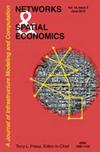新的国际陆海贸易走廊中国-东盟
IF 1.5
3区 工程技术
Q3 OPERATIONS RESEARCH & MANAGEMENT SCIENCE
引用次数: 1
摘要
近年来,为发展与东盟国家的对外贸易关系,中国开始建设新的国际陆海贸易走廊,作为实施中新(重庆)战略互联互通示范倡议的一部分。中国中西部省份向东盟国家的货物中转,依托成渝经济圈中心物流中心,将通过中国企业参与建设的泛亚铁路公路网。以及海南北部湾港、杨浦港的海上货物运输。《全面区域经济伙伴关系协定》(Comprehensive Regional Economic Partnership Agreement)的制定和批准,已成为中国与东盟国家、日本和韩国之间对外贸易量增长的推动力,需要采取适当措施确保区域货物过境。在这方面,中国已经成立了一个大型的全国性物流运营商,并计划到2025年在重庆建立一个金融中心,这将成为进一步发展人民币跨境支付和深化与东盟国家金融合作的重要平台。新走廊将大大减少中国西部省份到东盟国家的货物运输时间和成本。未来,通过成渝经济圈,连接欧亚陆海路和喀什瓜达尔港铁路(中巴经济走廊发展的一部分),也可以确保中西部地区进入欧洲、非洲、中东、南亚和中亚市场。中国正在努力将“一带一路”重塑为全球封闭物流路线,从加入的可能性和利用其协同和乘数效应,所有参与区域和全球过境交通的参与者都能获得显著和显著的利益本文章由计算机程序翻译,如有差异,请以英文原文为准。
New International Land-Sea Trade Corridor China – ASEAN
In order to develop foreign trade relations with the ASEAN countries in recent years, China has begun the construction of a new international land-sea trade corridor as part of the implementation of the China-Singapore (Chongqing) Demonstration Initiative on strategic interconnectedness. The transit of goods from the central and western provinces of China to the ASEAN countries, relying on the central logistics center of the Chengdu-Chongqing Economic Circle, will pass through the Pan-Asian Railway and Highway Network, that will be built with the help of Chinese companies. As well as by sea transportation of goods from the ports of Beibu Bay and Yangpu Port in Hainan Province. The development and ratification of the Comprehensive Regional Economic Partnership Agreement, which has become a generator of growth in the volume of foreign trade between China and the ASEAN countries, Japan, and the Republic of Korea, required adequate measures to ensure regional cargo transit. In this regard, a large national logistics operator has been founded in China, and there are plans to build a financial center in Chongqing by 2025, which will become an important platform for further development of cross-border payments in yuan and deepening financial cooperation with ASEAN countries. The new corridor allows to significantly reduce the time and cost of cargo transportation from the western provinces of China to the ASEAN countries. In the future, with the connection of the Eurasian land-sea route and the Kashgar-Gwadar Port railway (as part of the development of the Chinese-Pakistani economic corridor) through the Economic Circle of Chengdu-Chongqing, it also allows to ensure the access of the central and western region to the markets of Europe, Africa, the Middle East, South and Central Asia. China is striving to reformulate the Belt and Road route into a global closed logistics route, from the possibility of joining which and using its synergetic and multiplicative effects, all participants in regional and global transit traffic will be able to receive significant and significant benefits
求助全文
通过发布文献求助,成功后即可免费获取论文全文。
去求助
来源期刊

Networks & Spatial Economics
社会科学-运筹学与管理科学
CiteScore
4.00
自引率
4.20%
发文量
26
审稿时长
>12 weeks
期刊介绍:
Networks and Spatial Economics (NETS) is devoted to the mathematical and numerical study of economic activities facilitated by human infrastructure, broadly defined to include technologies pertinent to information, telecommunications, the Internet, transportation, energy storage and transmission, and water resources. Because the spatial organization of infrastructure most generally takes the form of networks, the journal encourages submissions that employ a network perspective. However, non-network continuum models are also recognized as an important tradition that has provided great insight into spatial economic phenomena; consequently, the journal welcomes with equal enthusiasm submissions based on continuum models.
The journal welcomes the full spectrum of high quality work in networks and spatial economics including theoretical studies, case studies and algorithmic investigations, as well as manuscripts that combine these aspects. Although not devoted exclusively to theoretical studies, the journal is "theory-friendly". That is, well thought out theoretical analyses of important network and spatial economic problems will be considered without bias even if they do not include case studies or numerical examples.
 求助内容:
求助内容: 应助结果提醒方式:
应助结果提醒方式:


